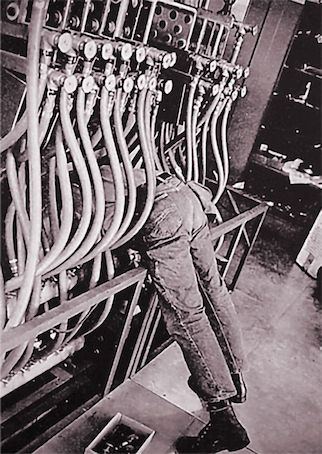
BIOGRAPHY
Gianandrea Gazzola, pseudonym of Giovanni Gazzola was born in Verona in 1948 to the architect Piero Gazzola and the painter Elena Schiavi. Having obtained his classical high school diploma at the Istituto Maffei in Verona, he enrolled at the Architecture faculty at Venice whilst simultaneously studying composition at Milan. From 1975 onwards he focused mainly on the relationship between sound and form, and experimented with crossing boundaries in music and sculpture.
Gazzola worked together with the composer Luciano Berio for much of the seventies. In later decades he increasingly became involved in teaching and experimented constantly with new technologies. This would lead him in 1985 to establish the L.I.S. (Laboratorio Informatica Spettacolo).
In addition to his work as a designer for several major international companies (Promemoria, Lucas, Luceplan, among others) the artist was involved in the theatrical scene as both composer and the creator of stage machinery and instruments, especially for the choreographies of Gianfranco Paoluzi.
From 1980 to 1985 he taught vocal technique in Florence at the Bottega Teatrale di Firenze run by Vittorio Gassman. From 1992 to 1997 he was an instructor in experimentation techniques at the Istituto Europeo di Design in Rome.
Since 2019 he teaches at the YACademy design and architecture school in Bologna.
In 2001 the Museo dell’Olio della Sabina was founded in Castelnuovo di Farfa, based on a project by the Benedetti di Martino studio in the 16th century Palazzo Perelli. It is a contemporary art museum composed of installations by Alik Cavaliere, Gianandrea Gazzola, Maria Lai, and Hidetoshi Nagasawa. From 2005 onwards he became part of the Spazi Consonanti group with Mao Benedetti, Sveva di Martino, Vania Gianese, Jacopo Benedetti and Stefano Scialotti. The group’s work focuses on the relationship between cultural heritage and contemporary art. Several projects came about, including those involving the Pompeii excavations: Prologo, and Elioforo, set up for the Antiquarium in 2008.
Since 2012 he has worked on the “Sub-Limine” installation at the Cisternone, an old, recently renovated rainwater collector in Seggiano. The installation writes and records in real time the electrical activity of the suspended roots of an olive tree, and was developed with Spazi Consonanti in collaboration with the LINV – International Laboratory of Plant Neurobiology, in particular with Professor Stefano Mancuso.
In 2013 he was commissioned his first work for the open-air exhibition Arte Sella.
In 2022, to mark the twentieth anniversary of the founding of the local museum, the Municipality of Castenuovo di Farfa commissioned him to create a new installation, based on the theme of landscape.
BIBLIOGRAPHY
• Carlo Amadori, Ugo La Pietra and Vincenzo Pavan, Raptus Europae, Florence, Alinea, 1990, ISBN 88-7743-098-2;
• R.Nicolini and M.Fiorentino, Roma Design Guide, Milan, Segesta, 1990, ASIN B000KSAJOY;
• I nuovissimi. Gianandrea Gazzola, MODO, n.120, Milan, January-February 1990;
• Carlo Amadori, Ugo La Pietra and Vincenzo Pavan, Progetti e Territori, Venice, Arsenale, 1991, ISBN 88-7743-095-8;
• Alberto Testa, I grandi balletti, Rome, Gremese, 1991, ISBN 88-7605-6015-7;
• Achille Bonito Oliva and Luigi Scialanga, Avvistamenti, Rome, Sprovieri, 1992, EAN 2560722003614;
• Achille Bonito Oliva, Imprimatur, Milan, Prearo, 1992, ISBN 8873480608;
• Industrial Design Review, Milan, ActionGroup, 1994, EAN 5000000132629;
• Gianandrea Gazzola: Tacet: macchine del silenzio, Roma in mostra, Rome, Gangemi, 1995;
• Alberto Abruzzese, Francesco Moschini and Yehuda Safran, Tacet: Macchine del silenzio, Rome, A.A.M.Architettura Arte Moderna, 1995;
• Astrid Högström, Villa Ottolenghi, FORUM for inredning, design & arkitektur, n. 4, Stockholm, 1996;
• Achille Bonito Oliva, Ineditoopen 96 - Premio Boccioni, Rome, Charta, 1996, ISBN 9788886158046;
• Giorgio Cortenova, Dadaismo dadaismi, da Duchamp a Warhol, Milan, Electa, 1997, ISBN 9788843562459;
• Emilio Del Gesso, I rapporti tra musica e Architettura: una mostra alla galleria A.A.M. in L'industria delle costruzioni, n.309, Rome, CDP, July 1997;
• Rachel Kaplan, Little Known Museums in and around Rome, New York, H.N.Abrams publishers, 2000, ISBN 0-8109-2914-7;
• Giancarlo Politi, Art Diary International, Milan, Politi, 2001, ISBN 978-8878161160;
• Giovanna Ralli, L'odore dell'erba, Solointerni, n.3, Rome, April 2001;
• E.Calabri and C.Cristallini, La provincia di Rieti. Repertorio dei monumenti, Rome, Gangemi, 2001, EAN 9788849201949;
• Maria Elena Palmegiani, El Museo del Aceite de la Sabina, un museo de arte contemporáneo, RdM. Revista de Museologia, n. 26, Madrid, 2003, pp. 115–118;
• A.Herbst, Rom: Das Museo dell'Olio für Wirtschaftsgeschichte, Kunstzeitung, n. 90, February 2004;
• Angelo Bottini, Il rito segreto, misteri in Grecia e a Roma, Milan, Electa, 2005, ISBN 9788837039134;
• Luce Plan, Euroluce 05, 2005, IPC 000005 / 8 032706 713962;
• DASA, Szenografie in Ausstellungen und Museen II, Essen, Klartext Verlag, 2006, ISBN 3-89861-462-X;
• Achille Bonito Oliva, Le opere e i giorni, Milan, edizioni SKIRA, 2006, ISBN 8876247696;
• H.C.Cousseau, G.Penone and F.Poli, Art en Sabine/Arte in Sabina, Paris, Ecole Nat.Sup.des Beaux-Arts, 2006, ISBN 978-2840561828;
• M.G.Di Monte, T.Calvano and P.Mangia, Museo tra passato e presente, Meltemi, Milan, Booklet Milano, 2008, ISBN 9788869164316;
• Silvia Dell'Orso, Musei e territorio. Una scommessa italiana, Milan, Mondadori Electa, 2009, EAN 9788837068097;
• Mariaclaudia Cristofano, Il museo verso una nuova identità. Esperienze museali di nuova concezione in Italia e nel mondo, Rome, Gangemi, 2011, ISBN 9788849221541;
• Giuseppe Tommasi, I disegni di Carlo Scarpa per casa Ottolenghi, edited by Alba Di Lieto, Milan, SilvanaEditoriale, 2012, ISBN 8836622933;
• Luca Zevi, Le quattro stagioni, Biennale di Venezia Architettura, Milan, Electa, 2012, ISBN 978-88-370-9322-8;
• European Landart Network, ELAN, Silvana Editoriale, 2015, ISBN 9788836631889;
• Emanuele Montibeller, Arte Sella. Coltivare l'arte, DOMUS, n. 1024, Milann, ED Editoriale Domus, May 2018;
• Maria Lai, Olio al pane e alla terra il sogno, Milan, Skira, 2019, ISBN 978-88-572-4184-5;
• Giacomo Bianchi, Dopo-After, Milan, Silvana Editoriale, 2021, ISBN 9788836648115.
• Maria Grazia Eccheli - Claudia Cavallo (a cura di), Il progetto nei borghi abbandonati, FUP-Firenze University Press, 2022, ISBN 978-88-5518-553-0.

gianandrea.gazzola@gmail.com